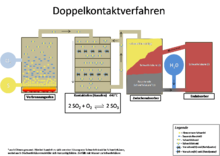Contact procedure
The contact process is a technical process for the production of sulfuric acid using a catalyst (e.g. vanadium pentoxide on silicon dioxide ). It was used on an industrial scale, but has since been further developed into a more profitable and environmentally friendly double contact process . The lead chamber method and the vitriol method were also used earlier .
While the lead chamber process dates from the mid-18th century, the contact process was patented by Peregrine Phillips in Bristol in 1831 , but the first industrial implementation did not start until around 50 years later - the first such system was built in Freiberg in 1875 . Initially, platinum was used as a catalyst, but the actual breakthrough only came after the introduction of vanadium as a catalyst (Chemico 1927). While the lead chamber process still accounted for around 75% in Europe and North America in 1910, it was below 75% in 1930 and only around 15% in 1960, with almost no new systems being built. Today it is completely superseded by the contact process.
Process description
In the first step of the process, sulfur dioxide is produced by burning sulfur. The air required for combustion must be sufficiently dried before use in order to avoid system corrosion and catalyst deactivation by sulfuric acid or sulphurous acid that would otherwise develop :
The sulfur is burned in excess air in a furnace with refractory lining to form a gas mixture with around 10 to 11% sulfur dioxide. After combustion, the gas must be cooled to around 410 to 440 ° C in order to set the temperature for the subsequent step of catalytic oxidation.
Sulfur dioxide can also be produced by roasting sulfidic ores:
The resulting sulfur dioxide is reacted with oxygen in an equilibrium reaction with a platinum - or vanadium catalyst (to - silica SiO 2 ) to sulfur trioxide reacted:
The sulfur trioxide obtained reacts with water to form sulfuric acid:
SO 3 has a higher solubility in H 2 SO 4 than in water. This creates disulfuric acid (also called fuming sulfuric acid or oleum):
This can then be mixed with water in order to obtain twice the amount of sulfuric acid used:
In most sulfuric acid plants, it is common to use approx. 97 to 99% sulfuric acid for the solution of SO 3 and to adjust the concentration of this sulfuric acid by adding water so that no smoking sulfuric acid is produced. In some sulfuric acid plants, however, oleum is deliberately produced, which is then not diluted with water but used for special purposes.
When the sulfur dioxide reacts with oxygen to form sulfur trioxide , it is important that the temperature does not exceed a range of 400–600 ° C.
catalysis
The essential reaction step is the oxidation of sulfur dioxide with atmospheric oxygen to sulfur trioxide with the aid of vanadium pentoxide as a catalyst . Vanadium pentoxide is not contained in the pores of the kieselguhr carrier as a solid, but rather dissolved in an alkali-sulphate melt when it is active. The melting temperature of the alkali sulfate therefore indicates the lower limit of use of the catalyst. More recent catalyst developments reduce this melting point and thus the lower limit of use by doping them with cesium.
In catalysis, the reactive species is a complex with the composition [(VO) 2 O (SO 4 ) 4 ] 4− . Oxygen is initially deposited on these, followed by sulfur dioxide. In two stages, a total of two molecules of sulfur dioxide react with the oxygen to form sulfur trioxide.
This sulfur trioxide is introduced into sulfuric acid and H 2 S 2 O 7 is formed , which reacts with water to form sulfuric acid.
Double contact method
The double contact process for the production of sulfuric acid is a further development of the contact process, but it is more profitable and environmentally friendly and is therefore used on an industrial scale today.
In contrast to the simple contact method, after passing through three contact trays and an intermediate absorber, the sulfur dioxide is passed over a further contact layer. The resulting sulfur trioxide is then dissolved in sulfuric acid in the end absorber. Modern plants achieve a conversion of sulfur dioxide of at least 99.8%.
literature
- OB Lapina, BS Bal'zhinimaev, S. Boghosian, KM Eriksen, R. Fehrmann: Progress on the mechanistic understanding of SO 2 oxidation catalysts. In: Catalysis Today . 1999, 51, pp. 469-479, doi : 10.1016 / S0920-5861 (99) 00034-6 .
- Mike Haustein: The contact process: an innovation from the Saxon metallurgy. In: Gesellschaft Deutscher Chemiker, Section History of Chemistry, Communications No. 25 (2017), pp. 164–189.
Web links
- Thomas Seilnacht: The double contact process clearly explained for chemistry lessons
Individual evidence
- ^ Leonard Friedman, Samantha Friedman, The History of the Contact Sulfuric Acid Process , web archive (PDF; 157 kB).
- ↑ History of the Contact Procedure (English), Ravensdown, web archive
- ↑ David M. Kiefer: Sulfuric acid: Pumping up the volume, ACS
- ^ A b c A. F. Holleman , E. Wiberg , N. Wiberg : Textbook of Inorganic Chemistry . 102nd edition. Walter de Gruyter, Berlin 2007, ISBN 978-3-11-017770-1 .
- ↑ Herbert Wiesenberger, Joachim Kircher: State of the art in sulfuric acid production. Federal Environment Agency , Monographs Volume 137, Vienna, 2001 ( full text pdf ).
- ↑ Thomas Seilnacht: Teaching Natural Sciences, DVD-ROM, Seilnacht Verlag & Atelier, Bern 2018, shorter version available on the Internet at: http://www.seilnacht.com/Lexikon/Doppelko.htm










